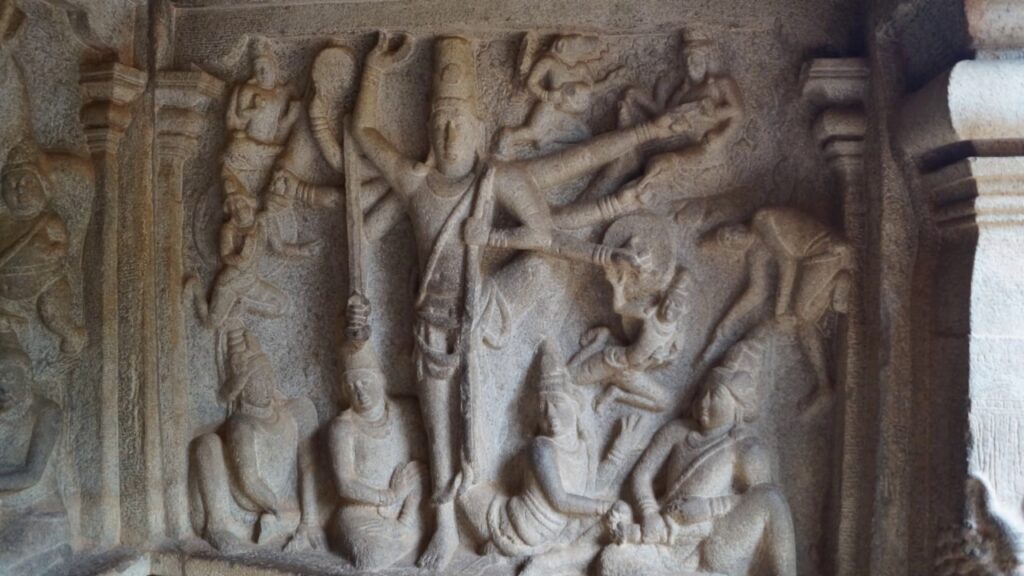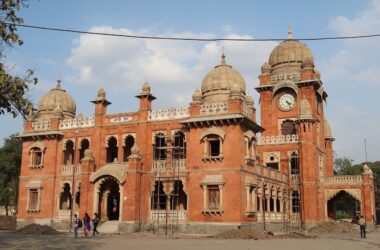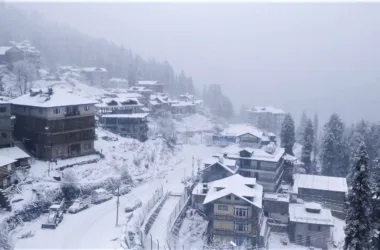Mahabalipuram’s architectural temples were built largely during the reign of Narasimhavarman and his successor Rajasimhavarman. This period clearly brings out the transition from rock-cut architecture to structural complex. The various mandapams (pavilions) and the rathas shaped as wooden chariots were etched out from a single piece of rock, while the famous Shore Temple, built half a century later, was carved out of stones of different dimensions, and assembled together later. Historical sights & Beach delights – Mahabalipuram.
The Shore Temple has beautiful bas reliefs including the 100-foot-long and 45-foot-high one carved out of granite. All the rathas except one are from the first phase of Pallava architecture, and are modeled on the Buddhist monasteries and Chaitya halls with several cells arranged around a courtyard. Art historian Percy Brown referring to Narasimhavarman’s victory in 642 AD over the Chalukyan king Pulakesin II, said that the Pallava king may have brought the masons and sculptors back to Kanchipuram and Mahabalipuram as ‘spoils of war’.
MAHABALIPURAM | 15 PLACES TO VISIT
Mahabalipuram Beach
Scattered with sculptural vestiges and an ancient shore temple in the center, the Mahabalipuram Beach is perhaps South India’s most atmospheric beach. A trip here is like waking up in another era where time stands still, the waves rush fast to break on the weathered periphery of a shore temple, and the sun casts an orange glow on sculptural panels, rock-cut caves and monolithic chariots that dot its brown sand. A lot of people come here to capture the dramatic beauty of these architectural pieces in the changing light of the sun.

Crocodile Bank
About 14-kilometer (8.75 miles) from Mahabalipuram on the Chennai-Mahabalipuram Road, the Crocodile Bank is an abode for crocodiles, alligators and snakes. For reptile lovers, this is in fact a great place to view crocodiles – thousands of them – in their natural environment. The snake farm is close to the crocodile bank; here anti-venom is produced for treating snakebites. A lot of visitors come here to go through the process of venom extracting; it helps the Irulas, a tribe of snake catchers, make a living. Crocodile Bank was set up by herpetologist Romulus Whitaker in 1976, to breed Indian and African crocodiles and alligators in captivity.

Sculpture Museum
Sculpture Museum is a must-do on your trip to Mahabalipuram. It opens up a world of sculptures most of which are depictions of gods and goddesses’ from Hindu mythology. On display are over 3000 sculptures, monolithic statues, chariots, sculpted reliefs and paintings that leave the history lover in you spellbound. The exhibits here are of immense historical significance, and reflect the glory of the bygone era.
Tiger Caves
These mysterious caves are about 5-kilometer (3.12 miles) north of Mahabalipuram in the pretty coastal hamlet of Salurankuppam. Set by the sea amid dense casuarinas in a landscape of small hillocks and big boulders, the Tiger Caves are actually rock-cut temples built in an open-air theatre style to host cultural events during the Pallava period. The main shrine is dedicated to Goddess Durga, while the entrance to the cave has carved heads of an animal that resembles a tiger. Legend has it that the animal depicted is the mythological ‘Yali’, thus the name ‘Yali Mandapam’.

Sadras
About 13-kilometer (8.12 miles) from Mahabalipuram towards Kalpakkam, there is an idyllic beach resort, Sadras, known for the ruins of a Dutch Fort. Take a stroll in the Dutch cemetery and look up the finely carved headstones and the inscriptions on them. Actually, Sadras is an anglicized version of the ancient town of Chadhuranga Pattinam. Sadras was set up in the 17th century as a Dutch colony, and an important centre for weaving fine muslin cloth for export. This little village was a flourishing weaver settlement until the Dutch conquered the domains from the Carnatic rulers in 1612.
Thirukadalmallai
Thirukadalmallai temple is a Pallava architectural specimen built to protect a wealth of sculptures from the turbulent sea. Dedicated to Lord Vishnu, and considered one of 108 ‘Divya desams’ (holy abode of Lord Vishnu), the temple is thronged by devotees and architecture lovers through the year. Its ambience is enhanced by an endless blue sea outside, and the row of casuarinas lining it. Do take time out to explore the tiny villages fringing the temple; they make all sorts of oddball handicraft and metal antiques. You can buy these souvenirs direct from the artisans.

Krishna’s Butterball
On the other side of the Mahabalipuram beach, a massive boulder looks to have stopped short of sliding down a smooth rocky slope. This gigantic boulder, about 5-meter in diameter, is called Krishna’s Butterball, and is set amid lush greenery. Among a spattering of hillocks, this particular rock – precariously resting at an angle of 45 degree – catches your eye first-up. The site is hugely popular with tourists who take to clicking goofy photographs with the rock in the background.

Mahishsuramardini Mandapam
Below the iconic lighthouse, along the road is another fascinating Pallava relic, a rock carving called Mahishasuramardini Mandapam. You can either take the staircase to the right or simply climb the plain ground, and it will lead you to the opening of the Mahishasuramardini cave. Carved out of a single rock on the side of a hill, the northern wall of the shrine has an elaborate depiction of the fierce combat between Goddess Durga and the buffalo-headed demon, Mahishasura. Mahishasura symbolizes raw power, ignorance and egoism. In the course of time, Mahishasura became so frightful that every celestial being dreaded the mention of him.

Descent of the Ganges and Arjuna’s Penance
A little away from the Ganesha Mandapam is a giant wall of open-air bas relief depicting the ‘descent of the Ganges’. In fact, the rock to the right hand side is called Descent of the Ganges and the one to the left, Arjuna’s Penance. It is quite fascinating how all the figures have been carved in a way that they either face the central cleft or appear to be moving towards it, and have their hands up in admiration. Another interesting depiction is that of a cat meditating near the leg of the bigger of the two elephants.

Varaha Cave Temple
Another paradigm of rock-cut architecture, the Varaha Cave temple was etched out on the rocky walls of a granite hill in the late 7th century by the Pallavas. This UNESCO World Heritage Site is a monolithic rock-cut temple with a mandapam that has on its inside walls gigantic sculpted panels depicting Lord Vishnu as Varaha, the boar, holding in his arms Bhu Devi, the earth goddess, and nuzzling her breast as he rescues her from the snake king who had abducted her under the ocean. The four columns lining the entrance to the cave have lion carved into their bases.

Krishna Mandapam
Adjacent to Arjuna’s Penance is another early rock-cut temple. This one is dedicated to Lord Krishna and depicts scenes of pastoral life. It is considered the biggest among the mandapams. Most prominently portrayed is the image of Krishna holding aloft the Govardhan Hill on his fingertip to provide shelter to the villagers of Gokulam and their animals from a raging storm. You will also see depictions of a shepherd milking a cow, a farmer carrying a child on his shoulder, a shepherdess carrying a pot of curd and a woman carrying on her head a rolled mat, and in her hand a tier of earthen pots.

Adivaraha Cave Temple
To the southwest of Mahishasuramardini Mandapam, an ancient cave temple with portrayals of Lord Vishnu as Varaha lies shrouded amid dense vegetation. At the entrance to the Adivaraha Cave you will be greeted by two sculptures of gatekeepers on either side. The inner walls of the cave are dense with sculptures of the ten incarnations of Lord Vishnu – the ninth one is believed to be Lord Buddha. Look up the northern wall for the depiction of Lord Shiva receiving the holy Ganges in his long locks tied up in a knot above his head.
Trimurti Cave Temple
Nestled on a 100-foot-high cliff, this 7th century rock-cut temple is dedicated to the three supreme deities of the Hindu pantheon, Brahma – the creator, Vishnu – the preserver, and Shiva – the destroyer. You will come across the carvings of a Shivalingam and Lord Brahma in the first two cells, while the third cell depicts Goddess Durga trampling Mahishasura’s (the buffalo-headed demon) head. Browse the rock-cut zoo adjacent to the cave temple; it has sculptures of an elephant, a calf, a monkey and a peacock.

Shore Temple
A UNESCO World Heritage Site, the shore temple was built in the 7th century by Narasimha Varman II facing the Bay of Bengal. The ‘Shore Temple’ is the lone survivor of the seven magnificent temple complexes, known as the seven pagodas, built near the sea. With five-storeys, shikharas and plunging eaves, it is one of the oldest South Indian temples built in Dravidian style. The complex spreads out over a square platform, and comprises three temples, of which two are east and west facing Shiva temples, and the third a Vishnu shrine in the center.

Pancha Pandava Rathas

You can easily get around the town on foot or by hiring a bike. Mahabalipuram is a relatively small town, and all the historical landmarks and points of sightseeing are within walking distance of each other. There are paid parking areas near the famed Shore Temple and the Pancha Pandava Rathas.
Related Article – HAMPI
Frequently Asked Questions About Things To Do In Mahabalipuram
Q. Which are the best places to investigate in Mahabalipuram on a cycling trip?
A. Cycling tours are the best way to explore as one gets to enjoy the rides of cycling along with it. The most famous places to visit on a cycling trip are Crocodile Bank, Tiger Cave and Kadumbadi Village.
Q. How many days are required to visit Mahabalipuram?
A. Mahabalipuram usually requires one full day to visit the most important attractions. Several tourists usually prefer visiting Mahabalipuram along with Kanchipuram or Pondicherry which requires an additional one day for Kanchipuram and 1-2 days for Pondicherry.
Q. What is the budget required to visit Mahabalipuram?
A. A budget of Mahabalipuram trip depends on the trip duration and category of hotel you choose for your stay along with the kind of vehicle you prefer. Mahabalipuram tour packages offered by Trawell.in start from as low as INR 5350 per person for a 2D/1N trip and from INR 7500 per person for 3D/2N vacation.
Q. Is Mahabalipuram worth a visit?
A. Mahabalipuram or Mamallapuram is an excellent destination with a great ambience, just a short drive away from Chennai along the superb ECR highway from Chennai to Pondicherry.
Q. Where to remain in Mahabalipuram?
A. Pick between the hiker inviting region around Othavadai Street, where spending inns and boutiques give the primary alternatives, and the gigantic retreats along the seashore. Then again, Chennai lies only two hours away by transport, such huge numbers of voyagers decide to remain in the enormous city toward the north and just take day trips Mahabalipuram.
Q. When can I visit the crocodile farm in Mahabalipuram?
A. The crocodile farm of the city is a major tourist attraction of Mahabalipuram. One can visit the farm any day except for Monday. The farm is open from 8:30 am to 5 pm and the charge for a single person is Rs. 35.
Q. Which are the activities that I can do in Mahabalipuram?
A. Fishing is a common occupation here and many tourists go on fishing expeditions here. Being a coastal town, Mahabalipuram has beaches where one can go surfing. Boat rides are a lot of fun in Mahabalipuram as it is not everywhere that people can go on boat rides in a sea.















